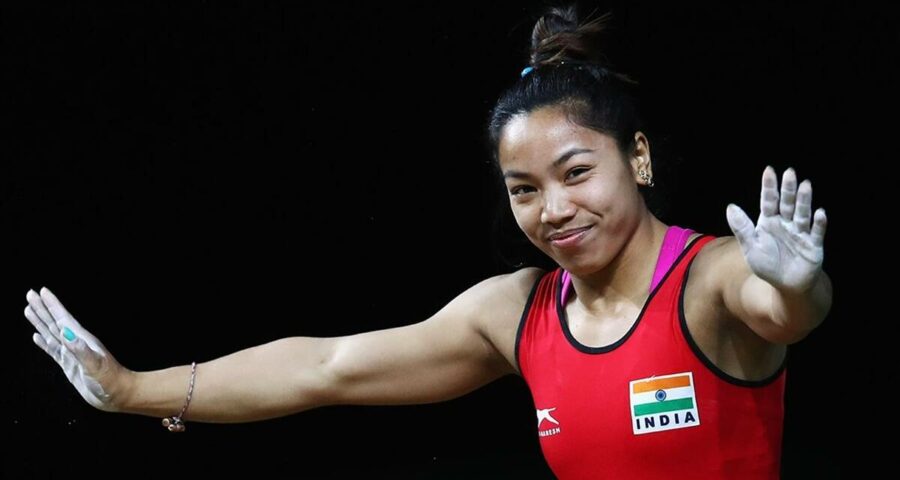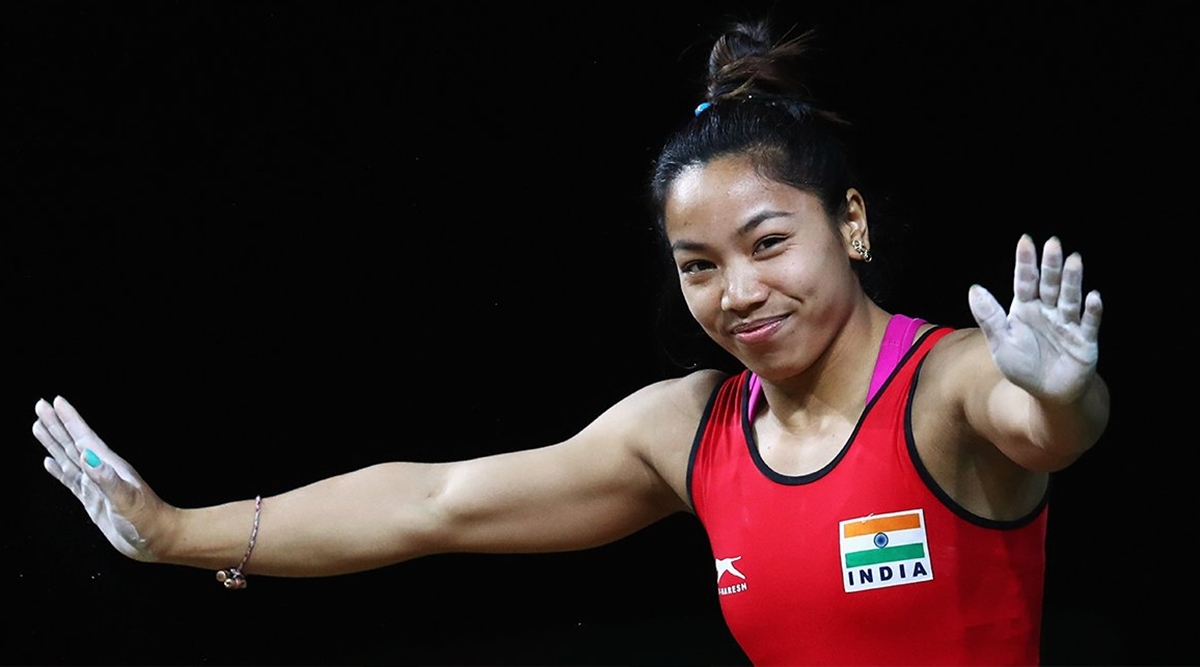After chronic back and shoulder problems put Mirabai Chanu’s weightlifting goals in doubt, a tweaked technique has put her back on track to ace the Tokyo Olympics.
Mirabai Chanu lifts weights more than twice her bodyweight for fun. But when a physiotherapist applied gentle pressure on her right hand, using just two fingers, it collapsed. “I thought, ‘am I so weak?’” Chanu laughs.
She isn’t, evidenced by her clean-and-jerk world record set during the Asian Championship last week. That 119kg lift, and the bronze medal that came with it, catapulted the weightlifter to the world’s elite in her 49kg class. It also raised hopes of her finishing on the podium on July 24, the opening day of events at the Tokyo Olympics.
Both these possibilities, however, looked distinct not too long ago. Chanu lifted hundreds of kilos of iron each day for years. That, though, bruised her body so much that in the middle of 2020, she couldn’t lift even half the load she normally would. An evaluation of Chanu’s condition by a former American weightlifter-turned-physiotherapist, Aaron Horschig read like this: “Right shoulder instability and weakness; left shoulder mobility restrictions; left hip mobility and stability problems; backache…” The list was endless.
So curious was Chanu’s case, in fact, that Horschig ended up making a half-hour show on her, calling it ‘Fixing the World Champions Weightlifter.’
‘Fixing’ Chanu looked an improbable task at one point. “We weren’t able to train,” says India’s weightlifting coach Vijay Sharma. “We were not even able to come close to lifting this kind of load.”
Sharma is talking about the phase just after last year’s nationwide lockdown. For almost two months, Chanu was forced inside her tiny room at the National Institute of Sport in Patiala. “Even if I miss training for just one or two days, I lose muscles. This lasted for two months,” she says.
The impact showed the moment the former world champion resumed training: the 26-year-old felt a twitch in her back and a sudden tightness in her shoulder. The dreaded memories of the painful injury she complained about just after the 2018 Commonwealth Games came flooding back. This time, it appeared more worrisome. The postponed Olympics were fast approaching. “But there wasn’t a single day where I was training without any pain,” Chanu says.
Pain, the constant companion
In the early part of the current Olympic cycle, the struggle was more on the mental aspect. Chanu was a medal potential even at the Rio Olympics. But on the day of her event, she froze. Three failed lifts in clean-and-jerk – one of the two events in Olympic weightlifting, the other being snatch – saw her crash out woefully.
The failure haunted her so much that Chanu was forced to take a few days break to take her mind off the game. She went a step ahead and contemplated quitting the sport altogether and she would have, had her mother Tombi not talked her out of it.
Chanu’s refreshingly positive outlook ensured she did not dwell on the ‘disaster’ for long. And Rio has turned out to be an aberration so far. In every competition since then, Chanu has only bettered herself. In 2017, she became only the second Indian after Karnam Malleswari to win the gold medal at the World Championship, lifting a total of 194kg. The following year, at the Gold Coast CWG, she won the gold by tallying 2kgs more.
With every tournament, Chanu was making her case stronger for an Olympic medal until suddenly, her back gave up. For months, India’s top doctors tried to diagnose, albeit in vain, the problem. Demons started dancing in her head again. “We didn’t know if she would be able to compete again,” Sharma says.
The pain abated as suddenly as it had surfaced. And nine months later when she returned, Chanu continued like she was never away from competition. At the continental championships in 2019, she bettered her CWG tally by three kilos to lift a total of 199kg. A few months later, at the World Championship in Pattaya last year, she crossed the 200kg-mark for the first time by totalling 201kg. “I improved in every tournament after Rio and after crossing 200kg, my confidence went really high,” Chanu says.
At the start of 2020, she had set her sights on a bigger total but the stop-start nature of Chanu’s Road to Tokyo took another twist. This time, more dramatic than before: The pandemic struck, a lockdown was announced and her training stopped. “It was one of the most difficult periods. More so, mentally,” Chanu says.
When the lockdown was partially lifted and training resumed, so did the back pain. This time it felt more severe.
“If I did heavy training one day, which is lifting around 75-80kg in snatch and up to 100kg in clean and jerk, then I had to give my body rest the entire next day. I couldn’t handle that much training because my back would get stiff,” Chanu recalls.
In late 2020, Sharma decided to take Chanu to St. Louis, USA.
American sojourn
“The purpose was two-fold,” Sharma explains. “It would help us get fresh mentally since we had spent the whole year inside NIS Patiala. Training in a different environment would break the monotony. The gym there was very modest and we didn’t have a lot to do in our free time. But the bigger factor was to get Mira checked by Dr. Aaron.”
‘Dr. Aaron’ Horschig is a former weightlifter who has competed till the national level in the USA. He is now one of the foremost physiotherapists, having worked with the Major League Baseball (MLB), America’s National Football League (NFL), football players and Olympic weightlifters.
Sharma says he went armed with all of Chanu’s medical reports. But Horschig diagnosed the issues within hours by observing her train. A lot of them, he noted, could have been due to faulty technique.
Chanu’s left shoulder, Horschig said, had mobility restrictions, which got evident during the drive phase in clean and jerk – the movement when the barbell is lifted overhead – the arm wobbled, thus affecting her lifts. The problem with the left shoulder resulted in more load on the right, which led to chronic pain that got accentuated because her right arm was weaker.
“Strength was not an issue for Mira,” Sharma says. “The problem, it turned out, was biomechanical. One shoulder was weak, which put the other under a lot more stress. That got sorted out.”
Her lower body, too, was affected. Horschig observed that with heavy squats, Chanu’s hip shifted to the left when she was on the ascent and during the turnover in snatch – going from squatting position to lifting the weights overhead – her body’s symmetry had a ‘significant problem.’
“She had difficulty in controlling her lower-body movement while squatting which put pressure on her lower back,” Sharma says.
Treating it wasn’t rocket science. Horschig used some corrective exercises and conditioning to reduce the stress on her shoulders and back.
“The results were quick. From not being able to practice two days in a row, I was having two sessions every day while in the USA,” Chanu says. “The fact that I could lift heavy weights in training without feeling uncomfortable in my back or shoulders was reassuring.”
Back with a new world record
That confidence translated in her performance at the Asian Championship last week, her first tournament in more than a year. Chanu admits there were ‘fears’ of not being able to replicate her training scores in competition. The fears compounded when her first two attempts in snatch were red-flagged.
But Chanu 2.0 – stronger physically and mentally, and with a sound technique – did not crumble under pressure this time.
Nothing more encapsulates Chanu’s transformation better than the fact that she now holds the world record in the very event where she flopped at the Rio Olympics. If Sharma had his way, he would bubble-wrap Chanu between now and the Olympics to keep her injury-free.
“But after her treatment, I feel a lot more secure. This world record lift would not have been possible if we had not gone to the USA,” Sharma says.
The Chinese team, he adds, kept one eye on Chanu throughout the event in Tashkent. Hou Zhihui and Jiang Huihua might be comfortably ahead of Chanu’s total but funnier things have happened at the Olympics. And if anything, they’re likely to keep a closer eye on Chanu between now and Tokyo.
Chanu says her competition isn’t with the Chinese. “I am competing with myself,” she says. “I failed in Rio. I have to make up for it in Tokyo.”
Source: Read Full Article


